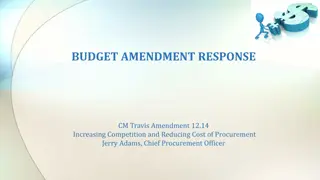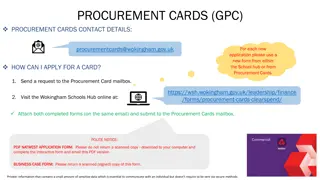Understanding the Steps of Pre-commercial Procurement
Pre-commercial procurement (PCP) involves the public procurement of Research and Development (R&D) services with a focus on competitive development in phases, risk-benefit sharing, and a clear separation between R&D and commercial deployment. The process includes steps for preparation, conducting, and transitioning to Public Procurement of Innovation (PPI). Competitive development in phases allows procurers to evaluate multiple R&D providers, leading to innovative solutions for challenges. Evaluation and selection criteria vary between traditional procurement and PCP, emphasizing the exploration of solutions, feasibility studies, and prototype development. The framework aims to increase R&D investment and mitigate risks by fostering innovation under market conditions.
Download Presentation

Please find below an Image/Link to download the presentation.
The content on the website is provided AS IS for your information and personal use only. It may not be sold, licensed, or shared on other websites without obtaining consent from the author. Download presentation by click this link. If you encounter any issues during the download, it is possible that the publisher has removed the file from their server.
E N D
Presentation Transcript
Steps during and after a Pre- commercial Procurement Riga, 9th of June 2016 9/21/2024 1
Pre-commercial Procurement Structure of the presentation 1. Introduction understanding PCP 2. Steps for preparing a PCP 3. Conducting a PCP & the PCP contractual framework 4. After the PCP link to PPI
Pre-commercial Procurement 1. Understanding PCP PCP is a public procurement of Research and Development (R&D) services characterized by: (i) competitive development in phases (ii) risk-benefit sharing under market conditions (iii)a clear separation between the procurement of the R&D from the deployment of commercial volumes of end- products
Pre-commercial Procurement 1. Understanding PCP Competitive development in phases: - competitive approach used in PCP by procurers to buy R&D from several competing R&D providers in parallel to compare and identify the best value for money solutions on the market to address the PCP challenge; - R&D split in phases: solution design, prototyping, original development and validation / testing of the first products; - the number of competing R&D providers is reduced after each PCP phase subsequent to intermediate evaluations.
Pre-commercial Procurement 1. Understanding PCP (GPA not applicable) Evaluation / Selection Evaluation / Selection (GPA applicable) Supplier X Tendering Tendering Supplier A 0 Supplier B Regular Public Procurement ? Supplier C Supplier C Supplier C Supplier A,B,C,D,E or X! Supplier D ? Supplier D Supplier E Supplier E 1 Supplier E 2 Pre-commercial Procurement of Innovation 3 Innovative 4 Public Procurement Phase 1: Solution Exploration Feasibility Study R&D Phase 2: R&D up to Prototype Phase 3: R&D up to first batch of pre-commercial volume pre-products/services validated via field tests Competitive space of the commercial off-the-shelf and ready-made solutions Scope of the current State Aid for R&D Framework Scope of the new State Aid for R&D and Innovation Framework Increasing R&D Risk Level - Increasing level of new R&D required
Pre-commercial Procurement 1. Understanding PCP Risk-benefit sharing under market conditions refers to the approach in PCP where procurers share with suppliers, at market price, the benefits and risks related to the IPRs resulting from the R&D. Separation from the deployment of commercial volumes of end-products refers to the complementarity of PCP, which focuses on the R&D phase before commercialization, and PPI, which does not focus on R&D but on the commercialization/diffusion of solutions.
Pre-commercial Procurement 1. Understanding PCP When to use PCP: PCP should be employed when R&D is needed to identify an innovative solutionto satisfy public procurers needs. The key requirement when PCP is envisaged is that no solution exist yet on the market to meet public procurers needs and, based on a search conducted by the procurers, it does not seem that such a solution will be available on a short term notice.
Pre-commercial Procurement 1. Understanding PCP Legal basis: TFEU 2007 PCP Communication 2007 Staff Working Document 2014 Framework for state aid for R&D&I PCP falls outside the public procurement directives: -> art. 14 PSD and art. 32 UD: this Directive shall only apply to public service contracts for research and development services [ ] provided that both of the following conditions are fulfilled: (i) the benefits accrue exclusively to the contracting authority for its use in the conduct of its own affairs, and (ii) the service provided is wholly remunerated by the contracting authority .
Pre-commercial Procurement 2. Steps for preparing a PCP Needs identification Prior art analysis & IPR search Market consultation Business case
Pre-commercial Procurement 3. Conducting a PCP a) Drafting the PP tender documentation PCP Contract Notice PIN (published in TED) PCP Request for tenders (ITT / Tender Regulation) PCP Framework Agreement PCP Phase 1 Specific Contract b) Conducting the procurement procedure Publication of te contract notice Selecting R&D suppliers and awarding the FA & PC The phased approach (from one phase to the other)
Pre-commercial Procurement 3. Conducting a PCP Drafting the PCP tender docs Description of the challenge and of the context of the procurement Technical specifications described in terms of outcome-based requirements / functional specifications Description of the procurement process Number of phases & resource allocation Moving from one phase to the other Distribution of rights and obligations regarding IPR Description of the legal, economic, financial and technical information (e.g., monetary k value, payment info, language of proposals etc.) The terms of presentation of the tenderers' offers and tendering requirements Exclusion, selection and award criteria Allocation of the weightings based on the importance of the criteria
Pre-commercial Procurement 3. Conducting a PCP Drafting the PCP tender docs Exclusion criteria (concerning the bidders) Could be based on the provisions in the EU procurement directives Selection criteria (concerning the bidders) Suitability to perform the professional activity Economic and financial standing of the bidder Technical and professional ability Helps procurers assess whether the bidders: Have previous experience on the type of contract tendered (R&D) Have qualified personnel to perform the contract Have access to required technical equipment
Pre-commercial Procurement 3. Conducting a PCP Drafting the PCP tender docs Award criteria (concerning the bid) based on MEAT in addition to price, the award criteria could include, for example, quality, implementation and impact . To be more clear: quality could refer to: the ability to address the challenge raised in the tender; the novelty/innovativeness of the proposed solution approach (progress beyond-state-of-the-art); the technological soundness of the solution concept; implementation could refer to the quality and effectiveness / appropriateness of the proposed R&D work plan and resource allocation; impact could refer to the added value for society/economy, the soundness of the commercialization plan etc.
Pre-commercial Procurement 3. Conducting a PCP Drafting the PCP tender docs PCP Framework agreement: Concluded with each successful bidder whose offer has been accepted against the selection and award criteria covers the terms and conditions that remain valid during all PCP phases and will not be renegotiated (Specific phase contracts will be issued for each phase of the PCP) establishes the rights and obligations of the parties thereto (the public procurer and the winning bidders) in relation to the R&D services procured via the PCP shall contain information about the procurer(s), applicable law, IPR provisions, the future procedure for implementing the different phases (including the format of the intermediate evaluations after the solution design and prototype development phases), etc..
Pre-commercial Procurement 3. Conducting the PCP procedure Publication of the contract notice Selection of R&D providers and awarding the framework agreement and Phase 1 contracts Conducting the phased approach Monitoring implementation of the FA & PC
Pre-commercial Procurement 4. After the PCP link to PPI Completion of the Phase 3 R&D services marks the end of the PCP procedure. Commercialization of solutions developed during the PCP by companies/consortia follows after the end of Phase 3 of the PCP and is strictly outside the scope of the PCP. The public procurer may decide after the PCP procedure to start a PPI procedure to purchase a commercial solution for the same challenge that was addressed through the PCP. PCP is also clearly separated from any potential subsequent purchases of commercial volumes of end- products by the procurer.
Pre-commercial Procurement 4. After the PCP Link to PPI The PPI must be conducted in full compliance with the applicable public procurement legal framework (EU and/or WTO GPA if applicable), to preserve international competition . A separate PPI allows procurers to receive proposals from companies that have developed products through other means than a PCP (e.g., through SME funding instruments, other R&D grants, own company R&D resources). The separate PPI prevent issues of foreclosing of competition and crowding out of private R&D investments.
Stephan Corvers Ana Lucia Jaramillo Corvers Procurement Services b.v. Email: s.corvers@corvers.com; a.jaramillo@corvers.com 9/21/2024 18









![Comprehensive Overview of Corruption Watch Submission on Public Procurement Bill [B18B-2023]](/thumb/138344/comprehensive-overview-of-corruption-watch-submission-on-public-procurement-bill-b18b-2023.jpg)













